Reports of drone use in war zones has not been positive. The US have used drones as killing machines, to target terrorists and in some cases they have ended up injuring and causing civilian fatalities.
Some NGOs have however found a new use for drones — instead of using them for airstrikes, they are being used to save lives.
“@UN: Humanitarians using UAVs #drones in Philippines, #Haiti 2 support disaster response http://t.co/ryre6MW4TY pic.twitter.com/XBJPnLT37Q”
— Bina Soley (@BinaSoley) November 5, 2014
Drones, otherwise known as Unmanned Aerial Vehicles (UAVs), have been used in various humanitarian crisis to help civilians as opposed to targeting them.
For example, small and lightweight UAVs were launched in the Philippines after Typhoon Haiyan in 2013; they were also used in Haiti, and more recently, after the earthquake in China.
The use of drones as a tool to aid and help people on the ground is increasing. It is because of their popularity that the United Nations recently published a report, titled Unmanned Aerial Vehicles in Humanitarian Response.
It documents how they have been used to collect data and information which has been imperative in saving lives.
"UAVs are increasingly performing civilian tasks as the technology becomes more common. In fact, 57 countries and 270 companies were manufacturing UAVs in 2013.
"Humanitarian organizations have started to use UAVs, including in Haiti and the Philippines, for data collection and information tasks that include real time information and situation monitoring, public information and advocacy, search and rescue, and mapping," the document states.
One such company that has been actively promoting and highlighting the importance of drones is UAViators. The company has over 2,000 members in 80-plus countries and there mission is to promote safe and coordinated use of UAVs.
They should be used for data collection, cargo delivery and communication services in humanitarian and development settings.
"We do this by developing and championing international guidelines for the responsible use of UAVs. We actively promote operational safety and document lessons learned and best practices. We never self-deploy. We only mobilize at the request of established humanitarian & development partners. We actively promote community engagement and educate UAV operators," a statement by UAViators read.
UAViators founder, Patrick Meier, documents one of the companies partners, Drone Adventures, as being pioneers in this industry.
Our latest conservation mission: drone-based 3D DSM used to preserve ancient bogs with ProNatura #DRONESFORGOOD http://t.co/t15uDwORAO
— Drone Adventures (@DroneAdventures) March 4, 2015
Drone Adventures had captured high quality aerial pictures after the disaster in the Philippines.
"They had snapped hundreds of aerial images using their 'eBee drones' to create a detailed set of 2D maps and 3D terrain models of the disaster-affected areas where the humanitarian organization, Medair works, enabling them to use UAVs to inform their recovery and rehabilitation programs," Meier said.
"They plan to use the UAV maps and models of hard-hit areas in Leyte, Philippines to assist in assessing 'where the greatest need is' and what level of 'assistance should be given to affected families as they continue to recover.'
"To this end, having accurate aerial images of these affected areas will allow the Swiss organization to 'address the needs of individual households and advocate on their behalf when necessary.' "
It is not just UAViators that has seen the benefit of drones. During the crisis in Nepal, several agencies used them for search and rescue missions and to map out toppled monuments, ruined heritage sites and devastated homes.
#Drones are helping protect Nepali quake survivors from landslides https://t.co/CDiqEEtzMe @Drones4Good pic.twitter.com/rPKsBEQzYQ
— SciDev.Net (@SciDevNet) May 6, 2016
In addition to this, The International Organization for Migration has been using drones since 2012 to capture the damage in Haiti after the devastating 2010 earthquake.
So drones can be a source of good, when used correctly and in the right situation.
Meier from UAViators believes that now we have seen the importance of UAVs in dealing with the aftermath of disasters, NGOs should start to consult with the local communities on how to effectively use them.
"So the question is no longer if, but rather how. How do we ensure that these promising technologies continue to have positive impact in humanitarian settings? How do we ensure that local communities have a say in how UAVs are used?" Meier said.
"In addition to these questions, there are growing concerns around safety, privacy, regulation and ethics that need to be tackled earlier rather than later. One way to address these challenges is by mobilizing a community of practice that can pro-actively discuss these issues."




